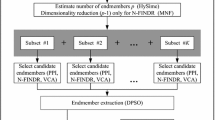Abstract
With the advancement in technology, hyperspectral images have potential applications in the field of remote sensing due to their high spectral resolution. Despite the hyperspectral image providing abundant information, its analysis suffers from the problem of high dimensionality. Hence, Dimensionality Reduction (DR) is an essential task in all hyperspectral image analysis. Band Selection, which is one of the DR techniques, is still a challenging issue even though many algorithms have been developed. To provide remedy for this issue, this paper explores a novel approach for band selection using K-means clustering on statistical feature in hyperspectral images. The proposed method of clustering based band selection for DR is simple and accurate. A reliable estimate of number of bands to be selected is provided by Virtual Dimensionality (VD). Informative bands preserving maximum information are selected based on the statistical feature, the variance using K-means Clustering technique. Further, our proposed work involves the utilization of the effectiveness of Simplex Growing Algorithm (SGA) on endmember extraction in association with clustering based band selection. Using Fully Constrained Least Squares (FCLS) method, abundance fraction is estimated based on endmember signatures, which are derived using Endmember Extraction Algorithm (EEA). The proposed work is investigated and compared with that of N-FINDR and Vertex Component Analysis (VCA) algorithms. The performance of the proposed algorithm is evaluated using Root Mean Square Error (RMSE), Spectral Angle Distance (SAD) and computation time. Experimental results show that the proposed clustering based band selection with SGA endmember extraction algorithm reduces the average SAD by 8 to 10 % and the average RMSE by nearly 1 %, compared to that of N-FINDR and VCA algorithms. In terms of computation time, the proposed band selection based DR with SGA algorithm is seven times faster than conventional transform based DR with SGA algorithm.











Similar content being viewed by others
References
Ahmad M, Haq DIU, Mushtaq Q, Sohaib M (2011) A new statistical approach for band clustering and band selection using K-means clustering. IACSIT Int J Eng Technol 3(6):606–614
Chang C-I (2003) Hyperspectral imaging: techniques for spectral detection and classification. Plenum, New York
Chang C-I, Du Q (2004) Estimation of number of spectrally distinct signal sources in hyperspectral imagery. IEEE Trans Geosci Remote Sens 42(3):608–619
Chang C-I, Du Q, Sun T-L, Althouse MLG (1999) A joint band prioritization and band-decorrelation approach to band selection for hyperspectral image classification. IEEE Trans Geosci Remote Sens 37(6):2631–2641
Chang C-I, Wang S (2006) Constrained band selection for hyperspectral imagery. IEEE Trans Geosci Remote Sens 44(6):1575–1585
Chang C-I, Wu C-C, Liu W-m, Ouyang Y-C (2006) A new growing method for simplex-based endmember extraction algorithm. IEEE Trans Geosci Remote Sens 44(10):2804–2819
Chang C-I, Wu C-C, Lo CS, Chang M-L (2010) Real-time simplex growing algorithms for hyperspectral endmember extraction. IEEE Trans Geosci Remote Sens 48(4):1834–1850
Chang C-I, Xiong W, Wu C-C (2013) Field-programmable gate array design of implementing simplex growing algorithm for hyperspectral endmember extraction. IEEE Trans Geosci Remote Sens 51(3):1693–1700
Du Q, Yang H (2008) Similarity-based unsupervised band selection for hyperspectral image analysis. IEEE Geosci Remote Sens Lett 5(4):564–568
Envi-Tutorials (2013) An overview of hyperspectral remote sensing. http://www.cossa.csiro.au/hswww/Overview.htm
Geng X, Sun K, Ji L, Ji L (2014) A fast volume-gradient based band selection method for hyperspectral image. IEEE Trans Geosci Remote Sens 52(11):7111–7119
Ghamary Asl M, Mobasheri MR, Mojaradi B (2014) Unsupervised feature selection using geometrical measures in prototype space for hyperspectral imagery. IEEE Trans Geosci Remote Sens 52(7):3774–3787
Harsanyi JC, Chang C-I (1994) Hyperspectral image classification and dimensionality reduction: an orthogonal subspace projection approach. IEEE Trans Geosci Remote Sens 32(4):779–785
Harsanyi J, Farrand W, Chang C-I et al. (1993) Determining the number and identity of spectral endmembers: an integrated approach using Neyman–Pearson eigen thresholding and iterative constrained RMS error minimization. Proc. 9th Thematic Conf Geologic Remote Sensing
Haskell KH, Hanson RJ (1981) An algorithm for linear least squares problems with equality and nononegativity constraints generalized. Math Prog 21:98–118
Heinz DC, Chang C-I (2001) Fully constrained least squares linear spectral mixture analysis method for material quantification in hyperspectral imagery. IEEE Trans Geosci Remote Sens 39(3):529–545
Lawson CL, Hanson RJ (1995) Solving least squares problems. classification in applied mathematics, PA: SIAM, 15
Martinez-Uso A, Pla F, Sotoca JM, Garcia-Sevilla P (2007) Clustering-based hyperspectral band selection using information measures. IEEE Trans Geosci Remote Sens 45(12):4158–4171
Mitra P, Murthy C, Pal SK (2002) Unsupervised feature selection using feature similarity. IEEE Trans Pattern Anal Mach Intell 24(3):301–312
Nascimento JMP, Dias JM (2005) Vertex component analysis: a fast algorithm to unmix hyperspectral data. IEEE Trans Geosci Remote Sens 43(4):898–910
Qian Y, Yao F, Jia S (2009) Band selection for hyperspectral imagery using affinity propagation. IET Comput Vis 3(4):213–222
Sohaib M, Haq I-U, Mushtaq Q (2013) Dimensional reduction of hyperspectral image data using band clustering and selection based on statistical characteristics of band images. Int J Comput Commun Eng 2(2):101–105
Sun K, Geng X, Ji L, Lu Y (2014) A new band selection method for hyperspectral image based on data quality. IEEE J Sel Topics Appl Earth Observ Remote Sens 7(6):2697–2703
Winter ME (1999) N-finder: an algorithm for fast autonomous spectral endmember determination in hyperspectral data. Imag Spectrometry V, Proc SPIE 3753:266–277
Zhu F, Wang Y, Fan B, Xiang S, Meng G, Pan C (2014) Spectral unmixing via data-guided sparsity. IEEE Trans Image Process 23(12):5412–5427
Zhu F, Wang Y, Xiang S, Fan B, Pan C (2014) Structured sparse method for hyperspectral unmixing. ISPRS J Photogramm Remote Sens 88:101–118
Acknowledgments
The authors would like to thank Mr. Feiyun Zhu who provided the hyperspectral dataset with ground truth.
Author information
Authors and Affiliations
Corresponding author
Rights and permissions
About this article
Cite this article
Veera Senthil Kumar G, Vasuki S Clustering based band selection for endmember extraction using simplex growing algorithm in hyperspectral images. Multimed Tools Appl 76, 8355–8371 (2017). https://doi.org/10.1007/s11042-016-3420-4
Received:
Revised:
Accepted:
Published:
Issue Date:
DOI: https://doi.org/10.1007/s11042-016-3420-4




